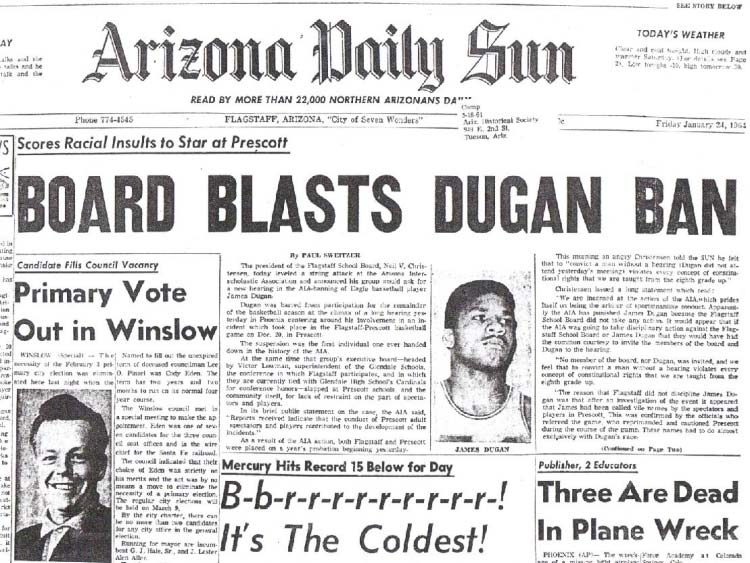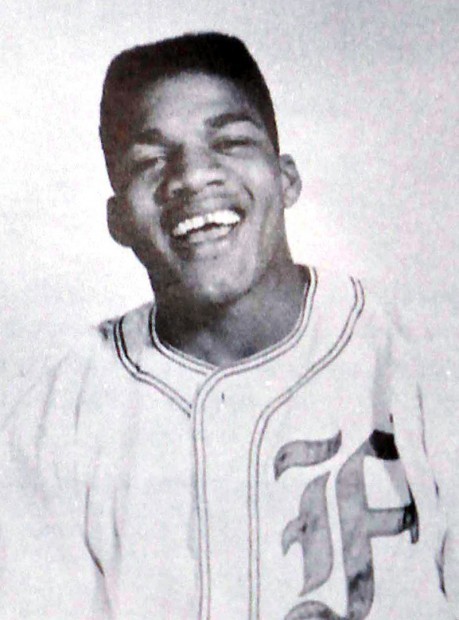The Power of Silence
June 17, 2020

It was 1974, my junior year of high school. My father, a long-time basketball coach, got one of the prized coaching jobs in the state at Flagstaff High School. We moved from Mayer, one of the smaller towns in Central Arizona, to Flagstaff, home to Northern Arizona University and a high school as large as the town I had come from. The high school was an old historic structure where some of the most prominent citizens of the state were educated.
In the early 1970s, Flagstaff was also a multiracial town, with significant numbers of African Americans and Hispanics. It was also home to one of the state’s largest Bureau of Indian Affairs dormitories at Flagstaff High School. It was on the fields and courts of the Flagstaff Eagles where I was first introduced to African Americans and other students of color. Indeed, in 1974-75 we had one of the finest basketball teams in the state, and it was largely due to two African-American brothers, Joe and James Joyce, and an African-American guard, Larry Johnson, who dominated play.
Although we certainly walked past each other in school, there were only a few Black and white students who crossed the cultural and racial “boundaries” to engage in true dialogue and friendship. We often did not know what to say to each other, and we feared the experience of the other. The one place where we came together was on Eagles athletic teams, and it was there where we finally began to negotiate the differences between our communities. In fact, it was on bus trips returning home from away games that we learned about the segregated nature of Flagstaff. It did not take long to notice that the Black players all got off the bus in one section of town near Kinsey Elementary School. Outside of school, we lived our lives in segregated areas of Flagstaff organized around race and class.
Player relationships on teams were often tense. There were harsh words at times and a few fights to settle widely differing perspectives on many issues. Still, there was something about the common goal of sports that kept us together. We all wanted to play, and we wanted to play well. The only way that happened was if we worked together. Very few adults helped model for us what it might look like for a Black man and white man to be friends. Most of our teachers and mentors seemed to fear conversations around race and difference. There were a few like my father, Doug Baker, and Paul Sweitzer who tried to serve as mentors. I am forever thankful for a teammate like Larry Johnson, who was willing to reach out a hand to help a young white guy from rural Arizona begin to negotiate life in a multiracial high school. He was the first to help me see the world from a Black man’s view.
There was one story that was told again and again by my Black teammates that helped me begin to see the world from their perspective. James Dugan was a Black student from 1960 to 1964 at Flagstaff High School. He was one of the finest athletes ever to play in the state, named first-team all-state nine times in three sports. He was one of the state’s greatest running backs and all-time scorers in basketball. He was unstoppable in almost any sport he chose to play and was chosen by sports writers at the turn of the century as one of the greatest athletes in Arizona history.

Although Flagstaff High School was integrated, the Eagles primarily competed against all-white teams in various sections of the state. Dugan was dominant, and teams struggled to stop him in every sport. In addition to trying to overcome the opposition, Dugan and his teammates often had to “take a pass” on the racial slurs that were hurled their way. One night, Dec. 20, 1963, on a basketball court in Prescott, Arizona, the racial slurs were used in such a way that James Dugan could no longer simply let them pass unnoticed. The head coach of Prescott High School decided that the best way to stop Dugan was to get his players to use the “n-word” and other racial slurs to enrage him. Dugan later said he spoke to the official about the abuse, and he replied, “C’mon, James, you will get your points, let it go.”
Toward the end of the game, Dugan could take the abuse no more. He turned around at one point and punched the player who was cursing him and knocked him out. A melee ensued with fans pouring out of the stands, and when the officials regained control Dugan was ejected from the game. The officials issued no penalty to the Prescott team or coach, whose behavior today would be considered reprehensible. After the game ended, one of Dugan’s teammates remembered that they had to lay down on the floor of the bus as local Prescott citizens literally “rocked” the bus and broke its windows as it headed out of town. A tragic night in Arizona athletic history.
Certainly, in today’s social media age, the story would have made national news. In late 1963, after evaluating the events of the evening, the Arizona Interscholastic Association placed both Flagstaff and Prescott high schools on probation. More importantly, they gave their first permanent suspension in the history of the organization to an individual player – James Dugan.
The AIA announced that it gave the suspension because the Flagstaff High School and board failed to penalize James Dugan themselves. Proudly, the Flagstaff School Board released this announcement in response to the AIA: “The reason that Flagstaff did not discipline James Dugan was that, after an investigation of the event, it appeared that James had been called vile names by spectators and players from Prescott (regarding his race). This was confirmed by the officials who refereed the game, who said that they had consistently warned the Prescott fans and coach during the course of the game.” One could be proud that Flagstaff stood with James Dugan at the time.
I do not know why a leader in the AIA did not recognize that punishing a young man being attacked for the color of his skin was wrong when the people who were behind the scheme deserved to be punished! No, the decision stood. Leaders of Prescott High School and the city of Prescott remained silent, complicit in the racist activity that was encouraged by their coach and fans in late December 1963. James Dugan’s basketball career ended abruptly on that night even though he was the one who experienced the injustice.
I think my Black teammates wanted me to hear that even though they were Flagstaff Eagles, the culture did not accept them as equals to the white players on the team. They lived in a different part of town, and even on the basketball court they were defined by their color. On that fateful night, no referee, no Prescott citizen, no one stood in the gap for James Dugan and stopped what was going on. The taunting went on for most of the game, and the people in the stands did not demand that “justice be done.” They accepted the race baiting as normal and in saying nothing they said everything. Although the Flagstaff School Board appealed the decision, James Dugan’s life was forever changed; his penalty remained. As you can tell, that story has stayed with me for more than 40 years.
I often have thought (until recently) that things are better today. But part of the reason I think that is because I do not experience what it means to be Black on a daily basis. A young alumnus, David Marvin, who plays basketball at noon with George Fox faculty and staff, discussed his own experience as a Black man in Oregon in a Facebook post. He relayed how many times he had been called the “n-word,”refused service, had his credit card questioned, and been stopped dozens of times by police. He says ...
“Growing up, my mom always taught me to not dress, talk, or act a certain way. I have come to realize that none of this truly matters in the grand scheme of things. Unless there is change, I will continue to be treated this way. I have a lot of friends who say, ‘You hunt and fish, you are the whitest Black guy that I know.’ If these things are continuing to happen to the person that you see as the whitest Black person, what is happening on a regular basis to other people of color?”
We must find ways to be in genuine relationship with our Black neighbors. We have to stand up when we see injustice and challenge the wrongs we see right in front of us. Silence is indeed not an option. I continue to think that if even one brave white soul at Prescott High School had stood up for James Dugan in December of 1963, that night would have ended differently. Not as a painful racist stain in Arizona's history, but merely as a hard-fought contest between equals.
Robin Baker, President